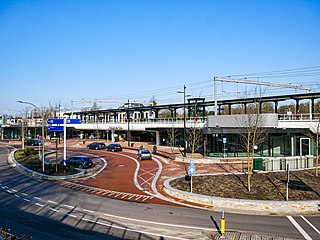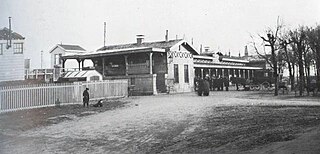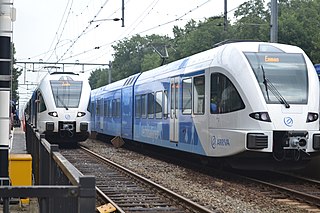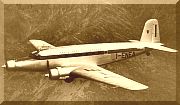
Driebergen-Zeist is a railway station located between Driebergen and Zeist, the Netherlands. It is located in the municipality of Utrechtse Heuvelrug. The station was opened on 17 June 1844 and is located on the Amsterdam–Arnhem railway. The station is operated by Nederlandse Spoorwegen. In 2018 there were approximately 8,787 passengers per day using Driebergen-Zeist station. The station was renovated from 2017 to 2020.

Schiedam Centrum is a railway station and metro station in Schiedam, just to the west of Rotterdam, Netherlands, on the railway line between The Hague and Rotterdam Centraal. Train services are operated by Nederlandse Spoorwegen, and metro, tram and bus services are operated by Rotterdamse Elektrische Tram.
The Halle train collision was a collision between two NMBS/SNCB passenger trains carrying a combined 250 to 300 people in Buizingen, in the municipality of Halle, Flemish Brabant, Belgium, on 15 February 2010. The crash occurred in snowy conditions at 08:28 CET (07:28 UTC), during rush hour, on railway line 96 (Brussels–Quévy) about 12 kilometres (7.5 mi) from Brussels between P-train E3678 from Leuven to Braine-le-Comte and IC-train E1707 from Quiévrain to Liège. A third train was able to come to a stop just in time. The collision killed 19 people and injured 171, making it the deadliest rail crash in Belgium in over fifty years.

The Schiedam train disaster took place in the Netherlands on 4 May 1976 near the station Schiedam Rotterdam-West. The international Rhine Express boat train from Hook of Holland, which left for Munich and was hauled by NS Class 1300 electric locomotive no. 1311 Best collided with a train of the then new sprinter type, coming from Rotterdam. The collision caused the deaths of 24 people, five people were severely injured and dozens more had minor injuries.

On 10 August, 1856 two passenger trains collided at the Amsterdam–Haarlem–Rotterdam railway near Delfshaven between Schiedam Centrum station and Rotterdam Centraal station, the Netherlands. Two carriages where destroyed with a third being severely damaged. Three passengers lost their lives and at least nine were injured.

The Winsum train disaster took place on 25 July 1980 near Winsum in the Dutch province of Groningen. Nine people died and 21 were injured.

The Dalfsen train crash occurred on 23 February 2016 when a passenger train collided with a tracked elevated work platform on a level crossing at Dalfsen, Overijssel, Netherlands. One person was killed and six were injured, one seriously.

The 1956 Punchbowl avalanche was a snow avalanche that occurred on 2 March 1956 on a mountain in Punchbowl, South Korea. The avalanche destroyed a base of the South Korean army. Over 100 soldiers were killed or missing.

The Transports Aériens Intercontinentaux Douglas DC-6B scheduled flight from Saigon, Vietnam to Paris, France crashed on 20 February 1956 before its third stopover 25 km North-East of Cairo International Airport due to crew error and possible fatigue. 52 people on board were killed.

On 24 November 1956 the Linee Aeree Italiane Douglas DC-6B "I-LEAD" was an international scheduled passenger flight from Rome via Paris and Shannon to New York. Shortly after take off from Paris Orly Airport the airplane lost altitude and crashed into houses in the commune Paray-Vieille-Poste. 34 of the 35 people on board were killed, including Italian orchestral conductor Guido Cantelli.

On 1 July 1948 the Avio Linee Italiane Fiat G.212PW “I-ELSA” was an international scheduled passenger flight from Linate Airport, Milan, Italy to Zaventem Airport, Brussels, Belgium. The airplane crashed during an emergency landing at 12:20pm local time. Eight of the twelve people on board were killed.
The 1874 Warmond train accident was a train collision between a passenger train and a freight train at the Amsterdam–Haarlem–Rotterdam railway near Warmond railway station between Leiden and Warmond, in the Netherlands on 14 August 1874. A passenger and one of the drivers were killed, and over 30 passengers were injured. The wife of the train driver died of shock after hearing her husband was killed.

A Faucett Perú operated domestic scheduled Lima–Huánuco–Tingo Maria passenger flight, operated with a Douglas C-54, crashed on 8 December 1967 against a mountain at Cordillera de Carpish. All 66 passengers and 6 crew members aboard were killed.
On 30 April 1979, Mount Marapi, a complex volcano on the Indonesian island of Sumatra and the most active complex volcano in West Sumatra province, erupted, killing between 80 and 100 people.
MV Lady Odiel, often written as MV Lady Odile, originally named MV Kalmarsund IX and later also renamed into MV Jomfruland, was a Swedish-built 487 GRT cargo ship in 1957 for Swedish company Angbats A/B Kalmarsund. She was acquired in 1964 by Swedish Andersson, AE, Rönnäng and in 1981 by the British Odiel Shipping Company.
On 4 October 1965, during the Apartheid in South Africa, a passenger train of the South African Railways with up to 1500 black commuters onboard derailed, killing 87 of them.

The 1994 Tolunda rail disaster happened near Tolunda, in the Namibe Province, Angola on 22 September 1994. A freight train of the Benguela railway derailed due to malfunctioning brakes and crashed into a 10 metres deep ravine. 300 people died and around 147 people were injured.












